Namaste
A Year of Yoga – How I Self Healed Injuries Using the World’s Oldest Healthcare System
Namaste, friends and fellow Yogi’s! If you’re not a regular yoga practitioner, you’re probably not familiar with this greeting, don’t worry, until recently, I wasn’t either. Almost exactly one year ago from the time of this writing I embarked on my journey into yoga, one which was prompted by an almost debilitating battle with chronic shoulder and neck pain. A year later, after making a serious commitment to try yoga as a holistic approach to self healing, the injury is healed and I am relatively pain free. Before I delve into the healing and transformation that happened over this life-changing year I’d like to tell you how I arrived at this place.
For most of my life I’ve been a musician, having earned a living as one for most of my adult life. I’ve been playing professionally on and off since 1989, having played thousands of night club gigs before moving from my native New England to Nashville, TN in 2002. Since my arrival to Nashville, I’ve played another thousand or so gigs, most of them as a professional touring musician. I even wrote a book about the Nashville music industry in 2011. About three years ago, the artist I was touring with decided to stop touring, and I used this moment to make a change. Having seen the country from a bus window several times over, I also decided to stop touring. I had no idea what I was going to do next.
A fellow musician whom I had played a few local gigs with owned a painting company, and one night on the way home from a local show said “If you ever feel like swinging a paint brush, let me know, I’m always looking for good help”. I took him up on his offer, as painting and drywall is something I’ve also done at different points of my life. At first I just worked a couple days a week, but a year later, now 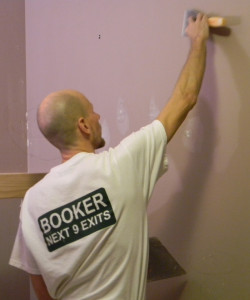 up to four to five days a week and still playing music part-time, this pace began to kick my ass! Not having done physical labor in over 10 years, I soon began having regular pain in my left shoulder and neck, as well as some relapses of tendinitis in my right arm from an old injury. The shoulder pain sometimes caused my neck to stiffen up, often to the point where I lost mobility and could barely turn my head to the side. It was getting ugly!
up to four to five days a week and still playing music part-time, this pace began to kick my ass! Not having done physical labor in over 10 years, I soon began having regular pain in my left shoulder and neck, as well as some relapses of tendinitis in my right arm from an old injury. The shoulder pain sometimes caused my neck to stiffen up, often to the point where I lost mobility and could barely turn my head to the side. It was getting ugly!
Like many Americans, I didn’t have health insurance, I haven’t for most of my adult life. So I knew I had to go about this holistically. I was already eating pretty well, as I had been for several years. I’m not vegan but I do eat lots of fruits and vegetables, whole grains, legumes, healthy oils, nuts, and lots of water, with meat and dairy only being a small part of my diet. I avoid processed foods and almost never eat in restaurants. As far as exercise, at the time these problems began, I had been doing the P90X workout program on an off for about two years, and sometimes went on hikes. I was relatively fit, but my exercise habits were inconsistent. I started doing the P90X stretch DVD on a regular basis, and while this seemed to help, it wasn’t enough. I started doing the resistance exercises again, and sometimes they seemed to help, other times they seemed to aggravate the injuries.
By the end of this second year of construction I was at my wits end, the nagging shoulder problem now an almost daily occurrence and the tendinitis not far behind. I was determined to remedy the situation holistically; I knew it could be done as my wife had just conquered a bad neck injury from a car accident through regular exercise. I needed a new approach, as it seemed like everything was just too tight and getting tighter – shoulders, neck, and a whole bunch of muscles I didn’t even know the names of. I had some earlier experiences with yoga, mostly from the P90X yoga DVD, and, remembering how good I felt after those workouts, I began exploring it again. Around the same point in time a friend of mine told me how he had used yoga to heal a chronic injury. For the next few months I began doing yoga, mainly using that DVD or just putting a few poses together on my own. I wasn’t doing it with any real consistency or plan, but I was doing it.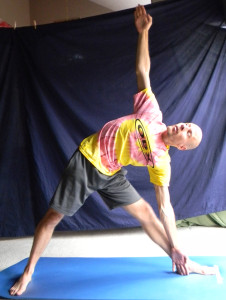
Then one day a bulb went off in my head. I remembered something that a Soft Tissue Specialist once told me about my tendinitis. He said something to the effect of:
“The tendinitis in your forearm is the result of inflamed tendons and muscles rubbing. There’s an overlapping series of tendons and muscles that go all the way from your wrist to the back of your shoulder. So the problems in your forearm are also related to tightness in your triceps, and shoulder. You can’t just work on the one area of inflammation, you need to stretch everything around it, lengthen everything.”
Realizing that my shoulder and neck problem likely worked in the same way, I figured that yoga might be the perfect choice for something to stretch and strengthen my whole body. Right around this time my wife sent me a couple of links to some yoga classes on YouTube, one of them was a 30 Minute Morning Yoga Class by Ali Kamenova. I’m not sure if it was the unique and challenging flow to this class, or maybe her soft, steady and almost hypnotic voice delivering detailed explanations of form with a cool, Bulgarian accent, but something just clicked for me when I did this class. This was the beginning of my serious commitment to yoga.
For the first couple of months into my new commitment I did this same 30 minute routine 3 to 4 times a week, basically every other morning. I noticed the shoulder pain was diminishing and I was becoming less “tweak prone”. I started experimenting with some of Ali’s other classes and honed in on a 66 minute Vinyasa sequence that covered all the basic poses, adding this to my weekly rotation. I also began doing regular cardio, the “run-walk–run” method, basically, interval running about 2 to 3 times a week. By the time six months had passed from my initial commitment I realized I hadn’t had any major flareups in a while. I found another challenging Ali video that resonated with me, “Arm Balances Emotional Release”, and added this to my weekly regimen of yoga and running. Ali’s style of yoga, “interval yoga”, is not your traditional yoga. Many of the videos add elements of strength training and cardio, making the classes challenging on many levels.
It’s not about the hour a day that I do yoga, it’s about the other 23 hours.
During the second half of this transformational year, I began to notice a lot of other changes happening. Not only was I in less pain, I felt stronger and noticed having more energy throughout my days. I noticed feeling less beat up when I awoke in the morning. A lot of other subtle changes were happening – better posture, body awareness, deeper breathing, I even noticed that my attitude was becoming more positive. I began to make the connection between negative thoughts and tension and pain. It was obvious that my exercise routines were improving many aspects of my life.
The intermittent shoulder and neck pain that started me on this journey was often triggered by many different things. Sometimes it was from looking up for extended periods of time at work, turning my head to the side in an unsupportive way; even sneezing could trigger a spasm. These spasms would escalate to the point of constant pain and tension in the shoulder, eventually working its way into my neck and causing a limited range of motion. Once a spasm began, it would take anywhere between three days and a week to get under control. It’s not like I’m invincible now, but I haven’t had a major spasm in over six months, and if I do have a tweak, it’s much smaller now and typically gone the next morning. I am certain that it was this serious commitment I made to myself that allowed me to self-heal these injuries, as my physical problems were worsening before this intervention and I never once went to a doctor for any of this.
The benefits of Yoga in everyday life
Life can be challenging, work can be hard, and nothing is ever easy. No matter what you do I’m sure there are moments throughout some of your days when you are in physical or emotional pain. Here are some of the concepts and practices I’ve learned from yoga that seem to help ease some everyday struggles.
Breathing – It seems ridiculous that fully grown humans would need to examine their breathing. But 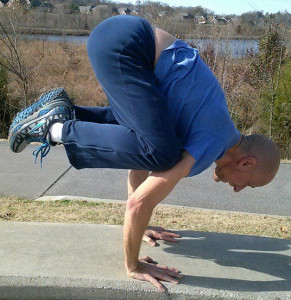 the truth is that many of us use shallow breathing much of the time. If you haven’t been doing yoga or another exercise in which breathing is integral, then you’ve probably never given it much thought. “Deep inhalations followed by deep exhalations”. Throughout my days, as often as possible, I check in with my breath. Am I breathing deeply or have I gotten lazy. Breathing deeply seems to help the body stay loose and the mind, calm and centered. Whenever I have to climb way up high on a ladder, I’ll take a few deep breaths first. I’ll do the same thing if someone cuts me off in traffic, if I feel an argument about to ensue, or if I’m getting nervous before a performance.
the truth is that many of us use shallow breathing much of the time. If you haven’t been doing yoga or another exercise in which breathing is integral, then you’ve probably never given it much thought. “Deep inhalations followed by deep exhalations”. Throughout my days, as often as possible, I check in with my breath. Am I breathing deeply or have I gotten lazy. Breathing deeply seems to help the body stay loose and the mind, calm and centered. Whenever I have to climb way up high on a ladder, I’ll take a few deep breaths first. I’ll do the same thing if someone cuts me off in traffic, if I feel an argument about to ensue, or if I’m getting nervous before a performance.
Posture – one of the best things about yoga is the emphasis on body alignment, and this transcends into posture. “Shoulders back and down, tuck your butt, lift through the crown of your head, relax your shoulders, don’t hyper extend your knees” – hearing these phrases repeated over and over in the workouts has helped me cultivate better posture even when I’m not working out. I can’t think of how many times throughout the day that I catch myself faltering when suddenly one of these phrases just pops into my head. I’ve also re-examined how I sit, often now choosing to sit crosslegged in a chair, or even on the floor. I believe good posture is half the battle.
Body Awareness – the more I do yoga, the more I become aware of how my body feels at any given moment in time and space. Now that I’ve got my two biggest ailments under control (the shoulder and tendinitis), I’ve become aware of other minor discomforts that have been there all along, possibly going back years. These are not a big problem; they are simply areas of tension or limited mobility to work on long-term. Also, if I’m pushing myself too hard throughout any given day or just getting tired, I become aware of growing tension and work to relieve it.
Stretching – a few times throughout my day, I’ll throw in a random stretching pose. I love to just hang in a forward fold for a minute or so right before lunch or driving home at the end of the day. Sometimes I’ll just do it if I feel myself getting tight. I’ll also do downward dogs, back bends, and other poses to counter building tension or tightness, when necessary.
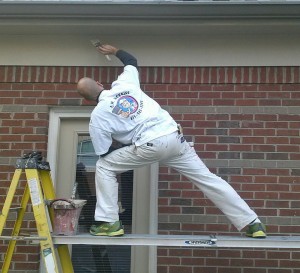 Body mechanics – to me this is the art of efficient and safe movement, and I’m aware of this now more than ever. What is the easiest way to do any given task? Whether it’s playing guitar, painting, sitting at a computer, I’m always searching for the safest and easiest way to do it.
Body mechanics – to me this is the art of efficient and safe movement, and I’m aware of this now more than ever. What is the easiest way to do any given task? Whether it’s playing guitar, painting, sitting at a computer, I’m always searching for the safest and easiest way to do it.
Attitude – Out with the negative in with the positive! Stress and tension can definitely cause physical pain, so it only stands to reason that having a positive outlook can make one healthier. One aspect of yoga is quieting and clearing the mind. Getting good at this seems to have a direct correlation to preventing injuries and living with less pain, not to mention, increased happiness. I find that the meditative aspect of yoga brings great inner peace and calmness.
Paying It Forward – Yoga has been such a powerful force in my life that I want to share with others, and I’ve already taught a few moves to a few friends. I have a long-term goal of becoming a yoga instructor, not to make a living from it (I’ve heard that’s pretty hard to do) but because I want to learn it on the deepest level possible and share that knowledge with others. Yoga seems to be female dominated, with many men shying away from it for a variety of preconceived notions. Seeing many of my friends living in pain has given me the desire to help change that and make yoga more accessible to men.
I can’t say enough good things about what yoga has done for me. I’ve learned entirely through home practice, almost exclusively using Ali’s videos. Ali has been a great teacher, responding to messages with advice and encouragement. She seems to do this for a huge amount of people all around the world. It’s an amazingly altruistic venture she has embarked on to make yoga so accessible to so many (she has over 200 free full-length yoga classes and tutorials on YouTube!), and to give such personal attention to everyone who seems to need help.
At age 46, I feel like I’m in the best shape of my life. No matter what fills my days – painting a house, 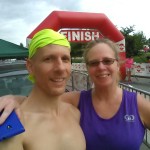 performing music, spending time with my family, running at the park, or yoga – I don’t think I’ve ever been in a happier, healthier place. We all live in varying degrees of pain, be it physical or emotional, and I believe yoga is the best pain management program of all time. There’s a reason it was invented and used over 5000 years ago as the original healthcare system in India. I’m grateful to be a part of this tradition and thankful that it found me. There’s still so much to be learned, so I better get started. Namaste!
performing music, spending time with my family, running at the park, or yoga – I don’t think I’ve ever been in a happier, healthier place. We all live in varying degrees of pain, be it physical or emotional, and I believe yoga is the best pain management program of all time. There’s a reason it was invented and used over 5000 years ago as the original healthcare system in India. I’m grateful to be a part of this tradition and thankful that it found me. There’s still so much to be learned, so I better get started. Namaste!
“The gesture Namaste represents the belief that there is a Divine spark within each of us that is located in the heart chakra. The gesture is an acknowledgment of the soul in one by the soul in another.
Nama means bow, as means I, and te means you. Therefore, namaste literally means “bow me you” or “I bow to you.”
Here’s some photos my wife took during one of my recent yoga sessions (click or swipe the arrows to see all the photos):
[wowslider id=”5″]
